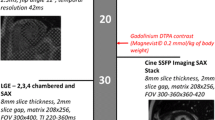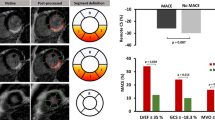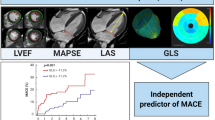Abstract
Background
The role of left ventricular (LV) myocardial strain by cardiac magnetic resonance feature tracking (CMR-FT) for the prediction of adverse remodeling following ST-elevation myocardial infarction (STEMI), as well as its prognostic validity compared to LV ejection fraction (LVEF) and CMR infarct severity parameters, is unclear. This study aimed to evaluate the independent and incremental value of LV strain by CMR-FT for the prediction of adverse LV remodeling post-STEMI.
Methods
STEMI patients treated with primary percutaneous coronary intervention were enrolled in this prospective observational study. CMR core laboratory analysis was performed to assess LVEF, infarct pathology and LV myocardial strain. The primary endpoint was adverse remodeling, defined as ≥ 20% increase in LV end-diastolic volume from baseline to 4 months.
Results
From the 232 patients included, 38 (16.4%) reached the primary endpoint. Global longitudinal strain (GLS), global radial strain, and global circumferential strain were all predictive of adverse remodeling (p < 0.01 for all), but only GLS was an independent predictor of adverse remodeling (odds ratio: 1.36[1.03–1.78]; p = 0.028) after adjustment for strain parameters, LVEF and CMR markers of infarct severity. A GLS > − 14% was associated with a fourfold increase in the risk for LV remodeling (odds ratio: 4.16[1.56–11.13]; p = 0.005). Addition of GLS to a baseline model comprising LVEF, infarct size and microvascular obstruction resulted in net reclassification improvement of 0.26 ([0.13–0.38]; p < 0.001) and integrated discrimination improvement of 0.02 ([0.01–0.03]; p = 0.006).
Conclusions
In STEMI survivors, determination of GLS using CMR-FT provides important prognostic information for the development of adverse remodeling that is incremental to LVEF and CMR markers of infarct severity.
Clinical Trial Registration
NCT04113356.




Similar content being viewed by others
References
Jernberg T, Johanson P, Held C, Svennblad B, Lindback J, Wallentin L (2011) Association between adoption of evidence-based treatment and survival for patients with ST-elevation myocardial infarction. JAMA 305(16):1677–1684. https://doi.org/10.1001/jama.2011.522
Zahler D, Lee-Rozenfeld K, Ravid D, Rozenbaum Z, Banai S, Keren G, Shacham Y (2019) Relation of lowering door-to-balloon time and mortality in ST segment elevation myocardial infarction patients undergoing percutaneous coronary intervention. Clin Res Cardiol 108(9):1053–1058. https://doi.org/10.1007/s00392-019-01438-6
Neumann JT, Gossling A, Sorensen NA, Blankenberg S, Magnussen C, Westermann D (2020) Temporal trends in incidence and outcome of acute coronary syndrome. Clin Res Cardiol. https://doi.org/10.1007/s00392-020-01612-1
Velagaleti RS, Pencina MJ, Murabito JM, Wang TJ, Parikh NI, D'Agostino RB, Levy D, Kannel WB, Vasan RS (2008) Long-term trends in the incidence of heart failure after myocardial infarction. Circulation 118(20):2057–2062. https://doi.org/10.1161/CIRCULATIONAHA.108.784215
Bauters C, Dubois E, Porouchani S, Saloux E, Fertin M, de Groote P, Lamblin N, Pinet F (2017) Long-term prognostic impact of left ventricular remodeling after a first myocardial infarction in modern clinical practice. PLoS ONE 12(11):e0188884. https://doi.org/10.1371/journal.pone.0188884
Bolognese L, Neskovic AN, Parodi G, Cerisano G, Buonamici P, Santoro GM, Antoniucci D (2002) Left ventricular remodeling after primary coronary angioplasty: patterns of left ventricular dilation and long-term prognostic implications. Circulation 106(18):2351–2357
Ponikowski P, Voors AA, Anker SD, Bueno H, Cleland JG, Coats AJ, Falk V, Gonzalez-Juanatey JR, Harjola VP, Jankowska EA, Jessup M, Linde C, Nihoyannopoulos P, Parissis JT, Pieske B, Riley JP, Rosano GM, Ruilope LM, Ruschitzka F, Rutten FH, van der Meer P, Authors/Task Force M, Document R (2016) 2016 ESC Guidelines for the diagnosis and treatment of acute and chronic heart failure: The Task Force for the diagnosis and treatment of acute and chronic heart failure of the European Society of Cardiology (ESC). Developed with the special contribution of the Heart Failure Association (HFA) of the ESC. Eur J Heart Fail 18(8):891–975. https://doi.org/10.1002/ejhf.592
Bulluck H, Dharmakumar R, Arai AE, Berry C, Hausenloy DJ (2018) Cardiovascular magnetic resonance in acute ST-segment-elevation myocardial infarction: recent advances, controversies, and future directions. Circulation 137(18):1949–1964. https://doi.org/10.1161/CIRCULATIONAHA.117.030693
Groot HE, Al Ali L, van der Horst ICC, Schurer RAJ, van der Werf HW, Lipsic E, van Veldhuisen DJ, Karper JC, van der Harst P (2019) Plasma interleukin 6 levels are associated with cardiac function after ST-elevation myocardial infarction. Clin Res Cardiol 108(6):612–621. https://doi.org/10.1007/s00392-018-1387-z
Bellenger NG, Burgess MI, Ray SG, Lahiri A, Coats AJ, Cleland JG, Pennell DJ (2000) Comparison of left ventricular ejection fraction and volumes in heart failure by echocardiography, radionuclide ventriculography and cardiovascular magnetic resonance; are they interchangeable? Eur Heart J 21(16):1387–1396. https://doi.org/10.1053/euhj.2000.2011
Reinstadler SJ, Thiele H, Eitel I (2015) Risk stratification by cardiac magnetic resonance imaging after ST-elevation myocardial infarction. Curr Opin Cardiol 30(6):681–689. https://doi.org/10.1097/HCO.0000000000000227
Schuster A, Hor KN, Kowallick JT, Beerbaum P, Kutty S (2016) Cardiovascular magnetic resonance myocardial feature tracking: concepts and clinical applications. Circ Cardiovasc Imaging 9(4):e004077. https://doi.org/10.1161/CIRCIMAGING.115.004077
Buckert D, Cieslik M, Tibi R, Radermacher M, Rasche V, Bernhardt P, Hombach V, Rottbauer W, Wohrle J (2018) Longitudinal strain assessed by cardiac magnetic resonance correlates to hemodynamic findings in patients with severe aortic stenosis and predicts positive remodeling after transcatheter aortic valve replacement. Clin Res Cardiol 107(1):20–29. https://doi.org/10.1007/s00392-017-1153-7
Heermann P, Fritsch H, Koopmann M, Sporns P, Paul M, Heindel W, Schulze-Bahr E, Schulke C (2019) Biventricular myocardial strain analysis using cardiac magnetic resonance feature tracking (CMR-FT) in patients with distinct types of right ventricular diseases comparing arrhythmogenic right ventricular cardiomyopathy (ARVC), right ventricular outflow-tract tachycardia (RVOT-VT), and Brugada syndrome (BrS). Clin Res Cardiol 108(10):1147–1162. https://doi.org/10.1007/s00392-019-01450-w
Hor KN, Gottliebson WM, Carson C, Wash E, Cnota J, Fleck R, Wansapura J, Klimeczek P, Al-Khalidi HR, Chung ES, Benson DW, Mazur W (2010) Comparison of magnetic resonance feature tracking for strain calculation with harmonic phase imaging analysis. JACC Cardiovasc Imaging 3(2):144–151. https://doi.org/10.1016/j.jcmg.2009.11.006
Khan JN, Singh A, Nazir SA, Kanagala P, Gershlick AH, McCann GP (2015) Comparison of cardiovascular magnetic resonance feature tracking and tagging for the assessment of left ventricular systolic strain in acute myocardial infarction. Eur J Radiol 84(5):840–848. https://doi.org/10.1016/j.ejrad.2015.02.002
Buss SJ, Krautz B, Hofmann N, Sander Y, Rust L, Giusca S, Galuschky C, Seitz S, Giannitsis E, Pleger S, Raake P, Most P, Katus HA, Korosoglou G (2015) Prediction of functional recovery by cardiac magnetic resonance feature tracking imaging in first time ST-elevation myocardial infarction. Comparison to infarct size and transmurality by late gadolinium enhancement. Int J Cardiol 183:162–170. https://doi.org/10.1016/j.ijcard.2015.01.022
Garg P, Kidambi A, Swoboda PP, Foley JR, Musa TA, Ripley DP, Erhayiem B, Dobson LE, McDiarmid AK, Fent GJ, Haaf P, Greenwood JP, Plein S (2017) The role of left ventricular deformation in the assessment of microvascular obstruction and intramyocardial haemorrhage. Int J Cardiovasc Imaging 33(3):361–370. https://doi.org/10.1007/s10554-016-1006-x
Eitel I, Stiermaier T, Lange T, Rommel KP, Koschalka A, Kowallick JT, Lotz J, Kutty S, Gutberlet M, Hasenfuss G, Thiele H, Schuster A (2018) Cardiac magnetic resonance myocardial feature tracking for optimized prediction of cardiovascular events following myocardial infarction. JACC Cardiovasc Imaging 11(10):1433–1444. https://doi.org/10.1016/j.jcmg.2017.11.034
Shetye AM, Nazir SA, Razvi NA, Price N, Khan JN, Lai FY, Squire IB, McCann GP, Arnold JR (2017) Comparison of global myocardial strain assessed by cardiovascular magnetic resonance tagging and feature tracking to infarct size at predicting remodelling following STEMI. BMC Cardiovasc Disord 17(1):7. https://doi.org/10.1186/s12872-016-0461-6
Gavara J, Rodriguez-Palomares JF, Valente F, Monmeneu JV, Lopez-Lereu MP, Bonanad C, Ferreira-Gonzalez I, Garcia Del Blanco B, Rodriguez-Garcia J, Mutuberria M, de Dios E, Rios-Navarro C, Perez-Sole N, Racugno P, Paya A, Minana G, Canoves J, Pellicer M, Lopez-Fornas FJ, Barrabes J, Evangelista A, Nunez J, Chorro FJ, Garcia-Dorado D, Bodi V (2018) Prognostic value of strain by tissue tracking cardiac magnetic resonance after ST-segment elevation myocardial infarction. JACC Cardiovasc Imaging 11(10):1448–1457. https://doi.org/10.1016/j.jcmg.2017.09.017
Ibanez B, James S, Agewall S, Antunes MJ, Bucciarelli-Ducci C, Bueno H, Caforio ALP, Crea F, Goudevenos JA, Halvorsen S, Hindricks G, Kastrati A, Lenzen MJ, Prescott E, Roffi M, Valgimigli M, Varenhorst C, Vranckx P, Widimsky P, Group ESCSD (2018) 2017 ESC Guidelines for the management of acute myocardial infarction in patients presenting with ST-segment elevation: The Task Force for the management of acute myocardial infarction in patients presenting with ST-segment elevation of the European Society of Cardiology (ESC). Eur Heart J 39(2):119–177. https://doi.org/10.1093/eurheartj/ehx393
Reindl M, Reinstadler SJ, Feistritzer HJ, Mueller L, Koch C, Mayr A, Theurl M, Kirchmair R, Klug G, Metzler B (2017) Fibroblast growth factor 23 as novel biomarker for early risk stratification after ST-elevation myocardial infarction. Heart 103(11):856–862. https://doi.org/10.1136/heartjnl-2016-310520
Klug G, Metzler B (2013) Assessing myocardial recovery following ST-segment elevation myocardial infarction: short- and long-term perspectives using cardiovascular magnetic resonance. Expert Rev Cardiovasc Ther 11(2):203–219. https://doi.org/10.1586/erc.12.173
Reinstadler SJ, Klug G, Feistritzer HJ, Kofler M, Pernter B, Gobel G, Henninger B, Muller S, Franz WM, Metzler B (2016) Prognostic value of left ventricular global function index in patients after ST-segment elevation myocardial infarction. Eur Heart J Cardiovasc Imaging 17(2):169–176. https://doi.org/10.1093/ehjci/jev129
Reindl M, Reinstadler SJ, Feistritzer HJ, Theurl M, Basic D, Eigler C, Holzknecht M, Mair J, Mayr A, Klug G, Metzler B (2017) Relation of low-density lipoprotein cholesterol with microvascular injury and clinical outcome in revascularized ST-elevation myocardial infarction. J Am Heart Assoc. https://doi.org/10.1161/JAHA.117.006957
Klug G, Mayr A, Schenk S, Esterhammer R, Schocke M, Nocker M, Jaschke W, Pachinger O, Metzler B (2012) Prognostic value at 5 years of microvascular obstruction after acute myocardial infarction assessed by cardiovascular magnetic resonance. J Cardiovasc Magn Reson 14:46. https://doi.org/10.1186/1532-429X-14-46
Bondarenko O, Beek AM, Hofman MB, Kuhl HP, Twisk JW, van Dockum WG, Visser CA, van Rossum AC (2005) Standardizing the definition of hyperenhancement in the quantitative assessment of infarct size and myocardial viability using delayed contrast-enhanced CMR. J Cardiovasc Magn Reson 7(2):481–485. https://doi.org/10.1081/jcmr-200053623
Reindl M, Tiller C, Holzknecht M, Lechner I, Hein N, Pamminger M, Henninger B, Mayr A, Feistritzer HJ, Klug G, Bauer A, Metzler B, Reinstadler SJ (2020) Aortic Stiffness and Infarct Healing in Survivors of Acute ST-Segment-Elevation Myocardial Infarction. J Am Heart Assoc 9(3):e014740. https://doi.org/10.1161/JAHA.119.014740
Freund A, Schock S, Stiermaier T, de Waha-Thiele S, Eitel I, Lurz P, Thiele H, Desch S (2019) Thrombus aspiration in patients with ST-elevation myocardial infarction presenting late after symptom onset: long-term clinical outcome of a randomized trial. Clin Res Cardiol 108(11):1208–1214. https://doi.org/10.1007/s00392-019-01452-8
Stiermaier T, Poss J, Eitel C, de Waha S, Fuernau G, Desch S, Thiele H, Eitel I (2018) Impact of left ventricular hypertrophy on myocardial injury in patients with ST-segment elevation myocardial infarction. Clin Res Cardiol 107(11):1013–1020. https://doi.org/10.1007/s00392-018-1273-8
Backhaus SJ, Kowallick JT, Stiermaier T, Lange T, Koschalka A, Navarra JL, Lotz J, Kutty S, Bigalke B, Gutberlet M, Feistritzer HJ, Hasenfuss G, Thiele H, Schuster A, Eitel I (2020) Culprit vessel-related myocardial mechanics and prognostic implications following acute myocardial infarction. Clin Res Cardiol 109(3):339–349. https://doi.org/10.1007/s00392-019-01514-x
Reinstadler SJ, Stiermaier T, Eitel C, Saad M, Metzler B, de Waha S, Fuernau G, Desch S, Thiele H, Eitel I (2016) Antecedent hypertension and myocardial injury in patients with reperfused ST-elevation myocardial infarction. J Cardiovasc Magn Reson 18(1):80. https://doi.org/10.1186/s12968-016-0299-1
DeLong ER, DeLong DM, Clarke-Pearson DL (1988) Comparing the areas under two or more correlated receiver operating characteristic curves: a nonparametric approach. Biometrics 44(3):837–845
Bochenek T, Wita K, Tabor Z, Grabka M, Krzych L, Wrobel W, Berger-Kucza A, Elzbieciak M, Doruchowska A, Gluza MT (2011) Value of speckle-tracking echocardiography for prediction of left ventricular remodeling in patients with ST-elevation myocardial infarction treated by primary percutaneous intervention. J Am Soc Echocardiogr 24(12):1342–1348. https://doi.org/10.1016/j.echo.2011.09.003
Ng VG, Lansky AJ, Meller S, Witzenbichler B, Guagliumi G, Peruga JZ, Brodie B, Shah R, Mehran R, Stone GW (2014) The prognostic importance of left ventricular function in patients with ST-segment elevation myocardial infarction: the HORIZONS-AMI trial. Eur Heart J Acute Cardiovasc Care 3(1):67–77. https://doi.org/10.1177/2048872613507149
Dagres N, Hindricks G (2013) Risk stratification after myocardial infarction: is left ventricular ejection fraction enough to prevent sudden cardiac death? Eur Heart J 34(26):1964–1971. https://doi.org/10.1093/eurheartj/eht109
Makikallio TH, Barthel P, Schneider R, Bauer A, Tapanainen JM, Tulppo MP, Schmidt G, Huikuri HV (2005) Prediction of sudden cardiac death after acute myocardial infarction: role of Holter monitoring in the modern treatment era. Eur Heart J 26(8):762–769. https://doi.org/10.1093/eurheartj/ehi188
Mann DL, Bogaev R, Buckberg GD (2010) Cardiac remodelling and myocardial recovery: lost in translation? Eur J Heart Fail 12(8):789–796. https://doi.org/10.1093/eurjhf/hfq113
Yamashita Y, Shiomi H, Morimoto T, Yaku H, Furukawa Y, Nakagawa Y, Ando K, Kadota K, Abe M, Nagao K, Shizuta S, Ono K, Kimura T, Investigators CR-KAR (2017) Cardiac and noncardiac causes of long-term mortality in ST-segment-elevation acute myocardial infarction patients who underwent primary percutaneous coronary intervention. Circ Cardiovasc Qual OutcomeS. https://doi.org/10.1161/CIRCOUTCOMES.116.002790
Holmes AA, Romero J, Levsky JM, Haramati LB, Phuong N, Rezai-Gharai L, Cohen S, Restrepo L, Ruiz-Guerrero L, Fisher JD, Taub CC, Di Biase L, Garcia MJ (2017) Circumferential strain acquired by CMR early after acute myocardial infarction adds incremental predictive value to late gadolinium enhancement imaging to predict late myocardial remodeling and subsequent risk of sudden cardiac death. J Interv Card Electrophysiol 50(3):211–218. https://doi.org/10.1007/s10840-017-0296-9
Biere L, Donal E, Jacquier A, Croisille P, Genee O, Christiaens L, Prunier F, Gueret P, Boyer L, Furber A (2016) A new look at left ventricular remodeling definition by cardiac imaging. Int J Cardiol 209:17–19. https://doi.org/10.1016/j.ijcard.2016.02.009
Reindl M, Reinstadler SJ, Tiller C, Feistritzer HJ, Kofler M, Brix A, Mayr A, Klug G, Metzler B (2018) Prognosis-based definition of left ventricular remodeling after ST-elevation myocardial infarction. Eur Radiol. https://doi.org/10.1007/s00330-018-5875-3
Ponikowski P, Voors AA, Anker SD, Bueno H, Cleland JGF, Coats AJS, Falk V, Gonzalez-Juanatey JR, Harjola VP, Jankowska EA, Jessup M, Linde C, Nihoyannopoulos P, Parissis JT, Pieske B, Riley JP, Rosano GMC, Ruilope LM, Ruschitzka F, Rutten FH, van der Meer P, Group ESCSD (2016) 2016 ESC Guidelines for the diagnosis and treatment of acute and chronic heart failure: the Task Force for the diagnosis and treatment of acute and chronic heart failure of the European Society of Cardiology (ESC)Developed with the special contribution of the Heart Failure Association (HFA) of the ESC. Eur Heart J 37(27):2129–2200. https://doi.org/10.1093/eurheartj/ehw128
Joyce E, Hoogslag GE, Leong DP, Debonnaire P, Katsanos S, Boden H, Schalij MJ, Marsan NA, Bax JJ, Delgado V (2014) Association between left ventricular global longitudinal strain and adverse left ventricular dilatation after ST-segment-elevation myocardial infarction. Circ Cardiovasc Imaging 7(1):74–81. https://doi.org/10.1161/CIRCIMAGING.113.000982
Funding
This study was supported by research grants from the 'Austrian Society of Cardiology' and by an intramural funding program of the Medical University Innsbruck MUI-START, Project 2015-06-013.
Author information
Authors and Affiliations
Corresponding author
Ethics declarations
Conflict of interest
The authors declared that they have no competing interest.
Ethics approval
The study conducted in compliance with the Declaration of Helsinki and received approval by the research ethics committee of the Medical University of Innsbruck.
Informed consent
All patients provided written informed consent before study inclusion.
Rights and permissions
About this article
Cite this article
Reindl, M., Tiller, C., Holzknecht, M. et al. Global longitudinal strain by feature tracking for optimized prediction of adverse remodeling after ST-elevation myocardial infarction. Clin Res Cardiol 110, 61–71 (2021). https://doi.org/10.1007/s00392-020-01649-2
Received:
Accepted:
Published:
Issue Date:
DOI: https://doi.org/10.1007/s00392-020-01649-2




